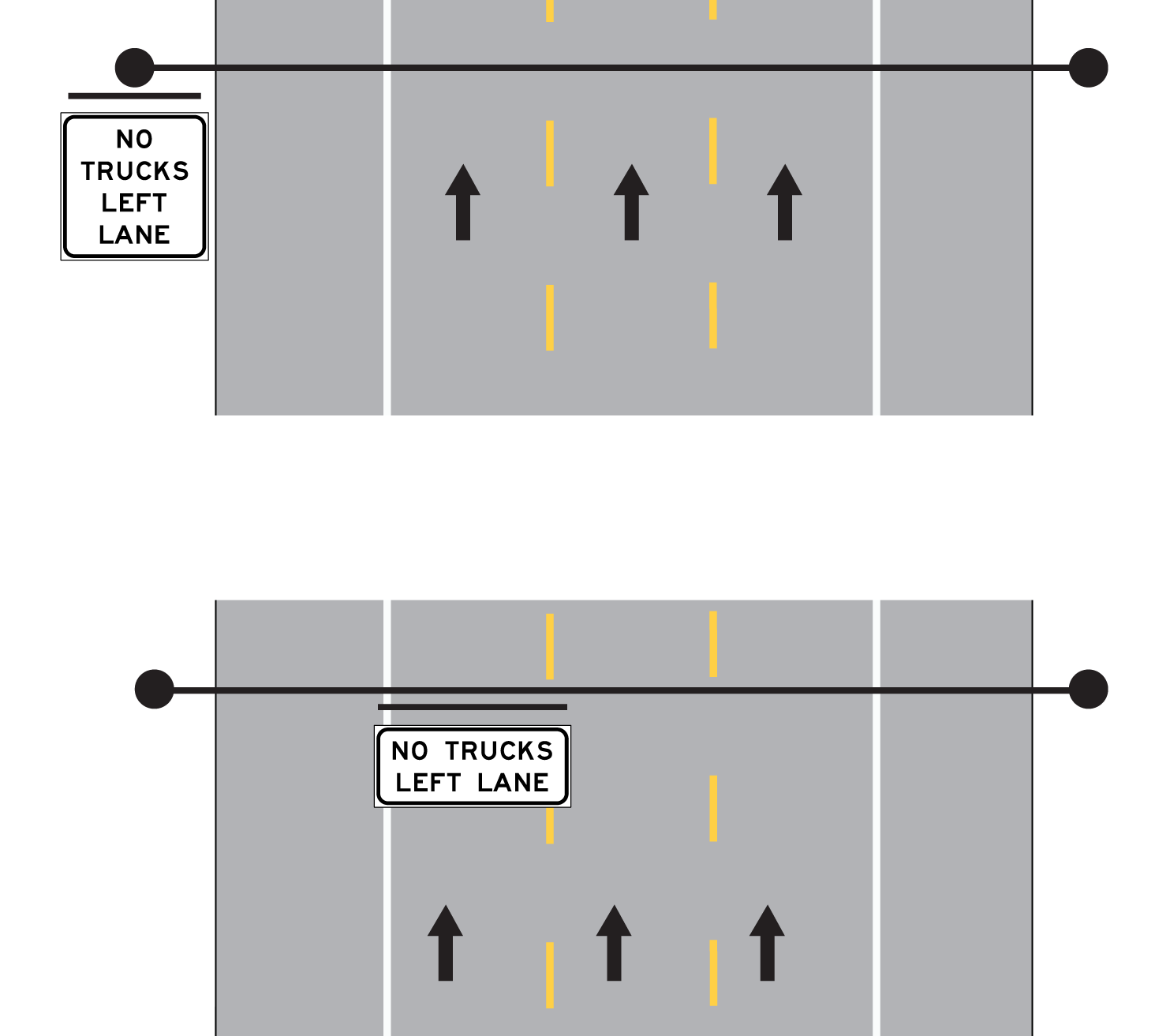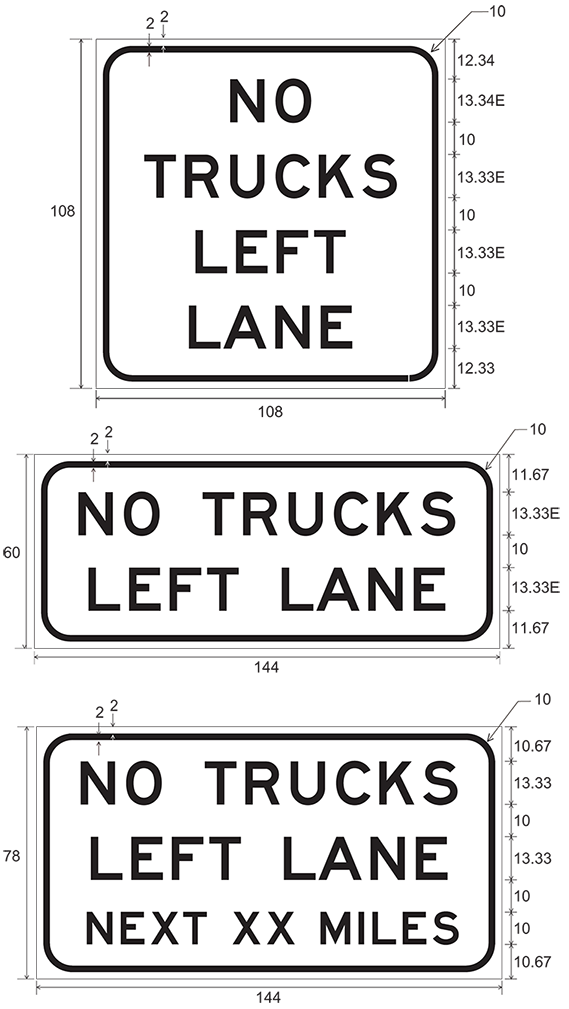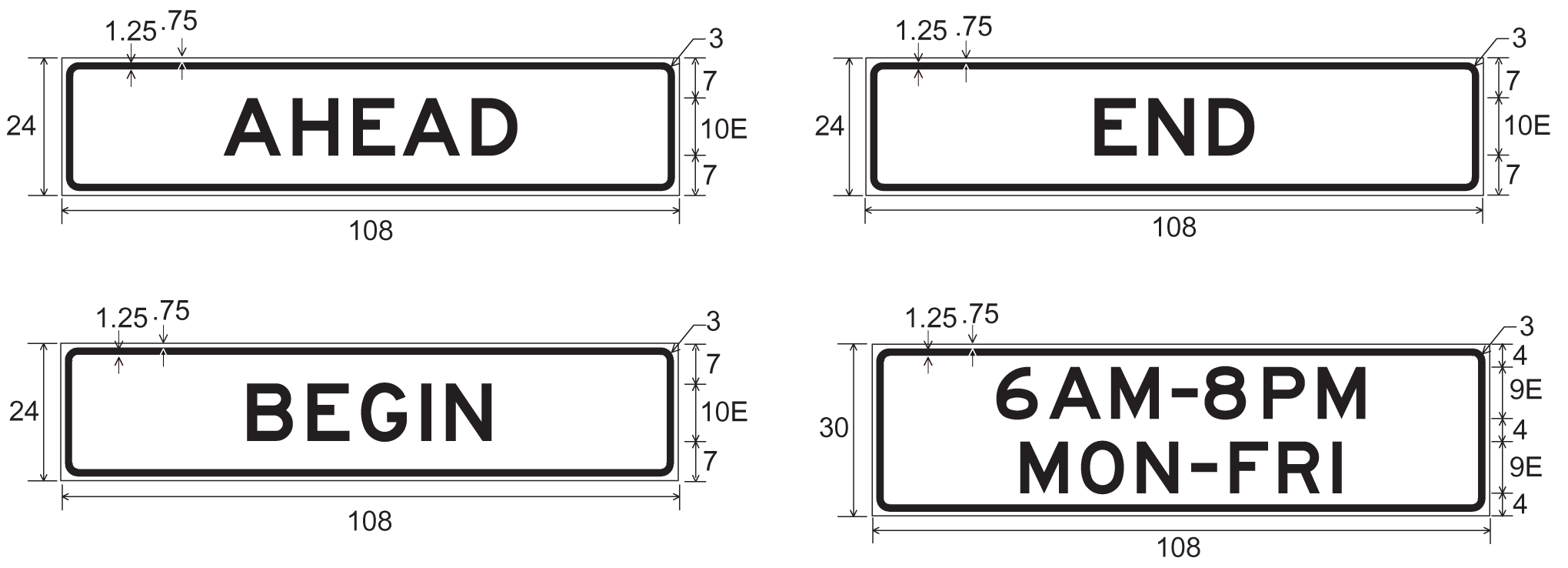Section 8: Restricted Truck Lanes
Anchor: #i1020856Introduction
The Texas Department of Transportation (TxDOT), cities, and counties are allowed to enact lane restrictions under certain circumstances. These restrictions typically prohibit trucks with three or more axles from using a particular traffic lane of a freeway with three or more lanes.
Anchor: #i1020876Authority
Rules for restricted truck lanes are contained in Texas Transportation Code, Sections 545.0651- 545.0653, and Texas Administrative Code (T.A.C.), Sections 25.601-25.604. These rules authorize a city, county, or TxDOT to restrict through traffic, by class of vehicle, to two or more designated lanes of traffic on certain portions of the designated state highway system.
As the state routing agency, TxDOT is required to approve all new lane restrictions or revisions to existing lane restrictions. A city or county cannot simply pass an ordinance or resolution to establish a lane restriction.
Anchor: #i1020930Terminology
Specialized terms used in this section are defined as follows:
- Anchor: #WLEABHKV
- Class
of Vehicle - all or any of the types of vehicles, machines,
tractors, trailers, or semitrailers, or any combination thereof,
propelled or drawn by mechanical power and used on a highway. A
vehicle class includes, but is not limited to:
-
Anchor: #GXKNKKLW
- a semitrailer Anchor: #WRXLBMSN
- special mobile equipment Anchor: #NPHUSVID
- a trailer Anchor: #NKVHJSYY
- a truck.
Anchor: #CIAGLSGH - Truck - a motor vehicle with three or more axles, designed, used, or maintained primarily to transport property. Anchor: #GHFOYNIU
- Truck Tractor - a motor vehicle designed and used primarily to draw another vehicle, but not constructed to carry a load other than a part of the weight of the other vehicle and its load. Anchor: #TBCGXJKJ
- Controlled Access Facility- as defined in Transportation Code §203.001, a designated state highway to or from which access is denied or controlled, in whole or in part, from or to adjoining real property or an intersecting public or private way, without regard to whether the designated state highway is located in or outside a local jurisdiction as defined below. Anchor: #QWFOTQVG
- Freeway - a public
roadway that:
- Anchor: #OMGLHJTU
- is in the designated state highway system Anchor: #UMEIVFCJ
- is designated a controlled access facility Anchor: #NDACOEBE
- has a minimum of three travel lanes, excluding access or frontage roads, in each direction of traffic that may be part of a single roadway or may be separate roadways that are constructed as an upper and lower deck.
Anchor: #XUSRJFPF - Local Jurisdiction - a home-rule, general‑law, or special‑law municipality incorporated under the laws of the State of Texas or any of the State’s 254 counties. Anchor: #DGDCIPEJ
- Order - a resolution or order of a county commissioner’s court or municipal ordinance. Anchor: #QUNAPDDA
- Transcript - a verbatim written record of a meeting required under this subchapter as prepared and certified by a court reporter or by an employee of a local jurisdiction and certified by an appropriate official of a local jurisdiction.
Who Initiates the Process?
A local jurisdiction or TxDOT may initiate the process of enacting a lane restriction.
Anchor: #i1023277Financial Responsibility
If local jurisdictions initiate the process of enacting a lane restriction, each local jurisdiction is responsible for all costs related to restriction development, including proposal preparation, local jurisdiction public hearings, and public information announcements regarding the order enforcing the restriction.
TxDOT will conduct the traffic study to evaluate the effect of the proposed restriction and will provide, install, and maintain appropriate traffic control devices along the restricted route.
If TxDOT initiates the process of enacting a lane restriction, then TxDOT is responsible for all costs associated with enacting the restriction, and will provide, install, and maintain appropriate traffic control devices along the restricted route.
Anchor: #i1023385Establishing a Lane Restriction
The process for establishing restricted truck lanes varies depending on how the process is initiated. The following three subsections describe the process when initiated by a single city or county, by contiguous cities or counties, and by TxDOT.
Anchor: #i1023470Single City or County Initiated Process
If a single city or county initiates the process for establishing restricted truck lanes, the process proceeds as follows:
- Anchor: #KMJEYGBK
- The city or county submits a description of the proposed restriction to the local TxDOT district. Anchor: #NORHSEKU
- The district conducts a traffic study to evaluate the probable effect. Anchor: #QCLBQWBP
- The city or county holds a public hearing. The notification of the public hearing must include a complete description of proposed restriction, including location, route numbers, and beginning and ending points of the restriction. A city council or commissioner's court meeting that allows the public to comment is acceptable. Anchor: #FDNGSDAG
- The city or county submits to the district
a formal proposal, which must include:
- Anchor: #WDDOYHBM
- six copies of the proposed ordinance Anchor: #CSEKPNNV
- documentation of a traffic study conducted in compliance with Section 545.0651 of the Texas Transportation Code Anchor: #XXJDRBMV
- two original plan views of the roadway Anchor: #TWXLKOGO
- signature of approval by an authorized city or county official Anchor: #QIQKJYLQ
- a transcript of any public comments received.
Anchor: #SSHGVGJQ - The district engineer sends the Traffic Operations Division (TRF) director the formal proposal from the city or county with the traffic study used to evaluate the impact. Anchor: #UVPPRVKV
- The district (through TRF) provides the
General Counsel Division (GCD) with a formal notice for publication
in the Texas Register, which includes:
- Anchor: #UGNPNMRP
- a complete description of the proposed restriction Anchor: #OGCSUXCK
- notification of the 30-day public comment period Anchor: #PPRLKGCG
- instruction to send comments to TRF.
Anchor: #TTXKIYSN - GCD handles publication in the Texas Register. Anchor: #KXXTPGID
- TRF receives comments resulting from the notice in the Texas Register. Based on the comments, the TRF director and the district engineer decide if and where a hearing will be held. Anchor: #UNRMVVYP
- TRF forwards the proposal package to the executive director for approval or disapproval. Anchor: #EAGSYNKS
- The executive director sends an approval or disapproval letter to the city or county with a copy to the district engineer and GCD. Anchor: #SYVKDUQM
- The city or county passes an ordinance or order. Anchor: #AHYTWLES
- The district funds and erects the signs.
NOTE: The executive director may suspend or rescind approval based on any of the following factors:
- Anchor: #WNWHBFFI
- changes in pavement conditions Anchor: #MSIMWMPR
- changes in traffic conditions Anchor: #TIYCSAJA
- geometric changes in roadway configuration Anchor: #ISRFACQA
- construction or maintenance activities Anchor: #QSFMJBQP
- emergency or incident management.
Contiguous Cities or Counties Initiated Process
If contiguous cities or counties jointly initiate the process for establishing restricted truck lanes, the process proceeds as follows:
- Anchor: #JWOYDLJI
- The cities or counties jointly submit a description of the proposed restriction to the local TxDOT district. Anchor: #HQIEDHQO
- The district conducts a traffic study to evaluate the probable effect. Anchor: #GMQUTPSI
- Each city or county holds a public hearing. Notification of the public hearing must include a complete description of the proposed restriction, including location, route numbers, and beginning and ending points of the restriction. A city council or commissioner's court meeting that allows the public to comment is acceptable. Anchor: #OAUOBXYV
- Each city or county submits to the district
a formal proposal, which must include:
- Anchor: #LGLWPBRV
- six copies of the proposed ordinance Anchor: #HFTGQOJG
- documentation of a traffic study conducted in compliance with Section 545.0651 of the Texas Transportation Code Anchor: #BXHEDXLR
- two original plan views of the roadway Anchor: #OMWSPNPV
- signature of approval by an authorized city or county official Anchor: #ULHTVGJD
- a transcript of any public comments received.
Anchor: #BLLCDKDE - The district (through TRF) provides the
General Counsel Division (GCD) with a formal notice for publication
in the Texas Register, which includes:
-
Anchor: #AFKQDNXP
- the date, time and location of the public hearings Anchor: #CIRDYMLT
- a complete description of the proposed restriction Anchor: #YOYBFIMK
- notification of the 30-day public comment period Anchor: #IOOUNWPV
- instruction to send comments to the district.
Anchor: #SJRJOQED - GCD handles publication in the Texas Register. Anchor: #RPGWEGJH
- The district holds at least one public hearing at the local district office or other suitable location. Notification of the public hearing must appear in the Texas Register at least 10 days prior to the date of the hearing. Anchor: #XDMXRXHX
- The district receives the comments resulting from the notice in the Texas Register. Based on the comments, the TRF director and the district engineer decide if and where another hearing will be held. Anchor: #JWDILIDN
- The district engineer sends to the TRF
director:
- Anchor: #UHPYOMIJ
- the formal proposal from each city or county Anchor: #COQLGPKC
- the traffic study used to evaluate the impact Anchor: #EGCNHFSM
- the transcript of public hearing held at the district office Anchor: #OBPBSWOS
- the written public comments received from the Texas Register.
Anchor: #BEKWMJLS - TRF forwards the proposal package to the executive director for approval or disapproval. Anchor: #BOGDQPPG
- The executive director sends an approval or disapproval letter to each city or county with a copy to the district engineer and GCD. Anchor: #GJEWOSWE
- The cities or counties pass ordinances or orders. Anchor: #BOWVEQRX
- The district funds and installs signs.
The executive director may suspend or rescind approval based on any of the following factors:
- Anchor: #AKYXXDGW
- changes in pavement conditions Anchor: #KOTQEYAD
- changes in traffic conditions Anchor: #PUQYIOLR
- geometric changes in roadway configuration Anchor: #TVJFHCOX
- construction or maintenance activities Anchor: #HNATSJPC
- emergency or incident management.
TxDOT Initiated Process
If TxDOT initiates the process for establishing restricted truck lanes, the process proceeds as follows:
- Anchor: #IDGEEXXU
- The district conducts a traffic study to evaluate the probable effects. Anchor: #HIOMMWTF
- The district consults with the affected city or county. Anchor: #ELMKLFRT
- The district (through TRF) provides GCD
with a formal notice for publication in the Texas Register,
which must include:
- Anchor: #FNWGPXYK
- the date, time and location of public hearings Anchor: #PSGINGGF
- a complete description of the proposed restriction Anchor: #JEPXTRXO
- notification of the 30-day public comment period Anchor: #RRBFYRJL
- instruction to send comments to district.
Anchor: #OSSWCWCX - GCD handles publication in the Texas Register. Anchor: #TKGRKPIE
- The district holds at least one public hearing at the local district office or other suitable location. Notification of the public hearing must be in the Texas Register at least 10 days prior to the date of the hearing. Anchor: #UVFQHBBM
- The district receives the comments from the notice in the Texas Register. Based on the comments, the TRF director and the district engineer decide if and where another hearing will be held. Anchor: #TQFHOUNJ
- The district engineer sends the TRF director
a formal proposal, which includes:
- Anchor: #UWLSTIPV
- a complete description of the proposed restriction Anchor: #JJJQGCUR
- documentation of a traffic study conducted in compliance with Section 545.0651 of the Texas Transportation Code Anchor: #IQWUKVKM
- two original plan views of the roadway Anchor: #TVJUTUGQ
- a transcript of any public comments received Anchor: #DWIYXYVJ
- written public comments received from the Texas Register.
Anchor: #OQFBVHPW - TRF consults with the district on preparation of a minute order. Anchor: #DSAUMBAD
- TRF submits the minute order to the executive director for Transportation Commission approval. Anchor: #RCRSGIPA
- The Commission approves or denies the minute order based on factors included in T.A.C. Section 25.604(f). Anchor: #EGYONLVU
- Upon approval, the district funds and installs the signs.
In an emergency, the executive director may temporarily suspend an existing restriction for 90 days based on any of the following factors:
- Anchor: #OXXWGMFL
- incident management Anchor: #BDQCSHRG
- inclement weather Anchor: #KEVPUKDE
- construction or maintenance activities Anchor: #INXVNCQQ
- other factors.
Example Signing for Left Lane Restriction
If a left lane restriction is established, the NO TRUCKS LEFT LANE sign should be mounted as close to the left lane as possible as shown in Figure 5-8. The sign can be mounted on:
- Anchor: #BTBYBBGI
- an overhead sign bridge or cantilever Anchor: #YSUUDHLN
- a large roadside sign support Anchor: #OQPNWQLK
- a tower of an overhead sign bridge or cantilever.
Figure 5-8. Typical signing for a left lane restriction on a freeway
Figure 5-9. Restricted truck lane sign details
Anchor: #i1029129Example Signing for Left Lane Restriction Plaques
Advance warning using the AHEAD plaque over the NO TRUCKS LEFT LANE sign should be used in advance of the restricted truck lane. The BEGIN plaque over the NO TRUCKS LEFT LANE sign and the END plaque over the NO TRUCKS LEFT LANE sign should be used at the restriction limits. If the restriction is not 24 hours a day, 7 days a week, then the restricted times should be mounted below the NO TRUCKS LEFT LANE sign. The typical plaques used in conjunction with the NO TRUCKS LEFT LANE sign are shown in Figures 5-10, 5-11, and 5-12.
Figure 5-10. Plaque details for large left lane restriction sign
Figure 5-11. Plaque details for overhead left lane truck restriction sign
Figure 5-12. Typical sign examples of left lane truck restriction sign with plaques




